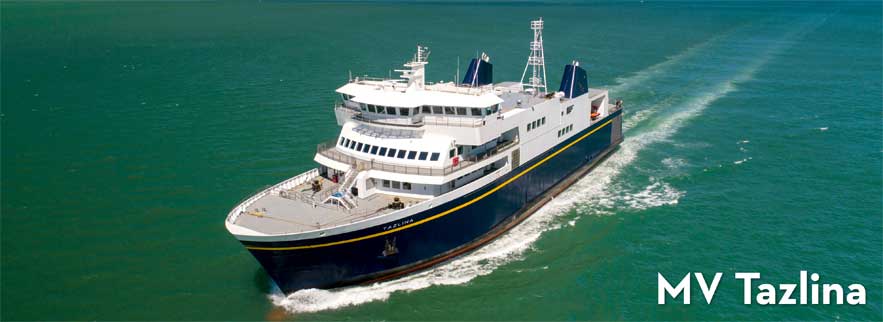Ships
The Alaska Marine Highway System operates a variety of ocean-going and small vessels, some of which are authorized for Foreign-Trade routes like Prince Rupert, British Columbia. Ships vary in age from the mid-1960's to those that went into service after 2005. Two new ships are scheduled to join the fleet late this decade. Not all vessels operate year around and are taken off-line for service and when passenger/vehicle loads are lighter.
The Alaska Ferries are well maintained, undergoing regular safety inspections, replacement of engines and other components as necessary. Let the agents at Viking Travel help you explore the vessels of the fleet.
The M/V AURORA, was built by Peterson Shipbuilders in Sturgeon Bay, Wisconsin, and began service in 1977. The Aurora is 235 feet long, and can transport 250 passengers and 34 vehicles (20' lengths) at a service speed of 14.5 knots. Because the Aurora is used for short runs, staterooms are not available, although food service and a solarium are provided

The M/V COLUMBIA was designed to carry 600 passengers with a crew of 66. Its two vehicle decks can accommodate 134 vehicles. There are 56 two-berth cabins plus 3 two-berth barrier-free cabins, 40 four-berth cabins and five cabins that have four-berths with an extra sitting room.

A typical Two-Berth Outside Cabin or Stateroom on most of the ships provides private facilities (toilet, shower and sink) and a view!

The cabins with the sitting rooms are great for a card party or to use with larger families that don't mind putting the kids on the floor in sleeping bags.
There is also a dining room, snack-bar, cocktail lounge as well as the ships gift shop, theater-lounge and video arcade are all available onboard. Two forward lounges afford wonderful vistas of the passing scenery. You can also roll out your sleeping bag on deck chairs and camp out under the heated Solarium, or, you may want to try one of the two decks ideal for pitching "free standing" tents and sleep under the stars. The M/V Columbia usually operates round-trip from Bellingham WA to Skagway AK on a weekly basis during the summer.
The M/V KENNICOTT, is a recent addition to the Marine Highway Fleet. Built by Halter Marine Group of Gulfport, Mississippi at a cost of over $80 million, the Kennicott began service in the summer of 1998. Designed by Halter Marine, and Glosten Associates of Seattle, Washington, the Kennicott is 382 feet long, 85 feet wide, with nine decks. She is driven by two 6,69HP Wartsilla 32E diesel engines, and has a service with a speed of 16.75 knots. The vessel is ocean certified and is also designed to serve as a command and logistics center during an oil spill or other natural disaster. The ship has a capacity for 499 passengers, provides 320 berthing accommodations and has space for 80 standard automobiles. The observation lounges and the enclosed, heated solarium give excellent vantage points from which to enjoy Alaska's scenic splendor throughout her voyage. The Kennicott operates on the Cross-Gulf schedule and also offers direct bi-monthly service between Washington State and Whittier Alaska (near Anchorage) during the summer.
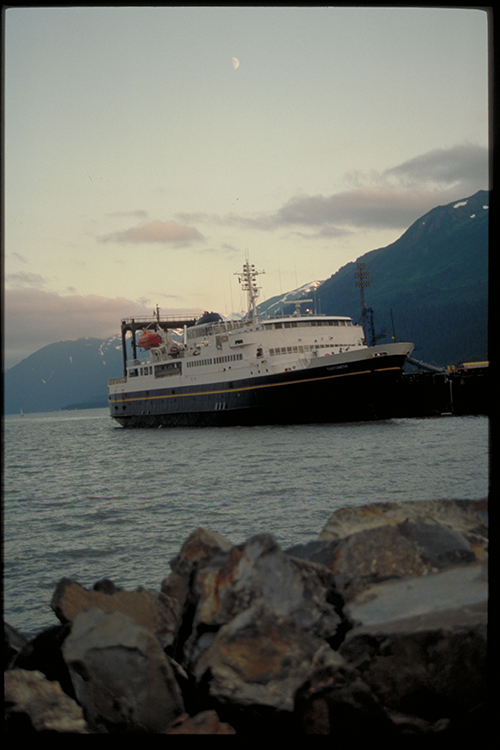
The M/V LECONTE, launched in late 1973 by Peterson Shipbuilders in Sturgeon Bay, Wisconsin. The LeConte joined the fleet in 1974. The LeConte is 235 feet long, with capacity for 300 passengers and 34 vehicles, and operates at a service speed of 14.5 knots. The LeConte is used for shorter runs, usually out of Juneau, so it does not have staterooms, but food service, cocktail lounge and a solarium are provided.

The M/V MATANUSKA, was built by Puget Sound Bridge & Dry Dock Company of Seattle and began service in 1963. In 1968 the vessel was lengthened and renovated. It now carries 500 passengers, and provides 4 four-berth, 23 three-berth, and 81 two-berth cabins. The Matanuska is 408 feet long, with capacity for 88 vehicles, and has a service speed of 16.5 knots. Passenger services include a cafeteria, gift shop, cocktail lounge, solarium and forward observation lounge. When you travel on the Matanuska ask us about the great staterooms that are availble at little or no extra charge! The Matanuska sails mainly within the inside passage during the summer months from Prince Rupert to Skagway with stops along the way.
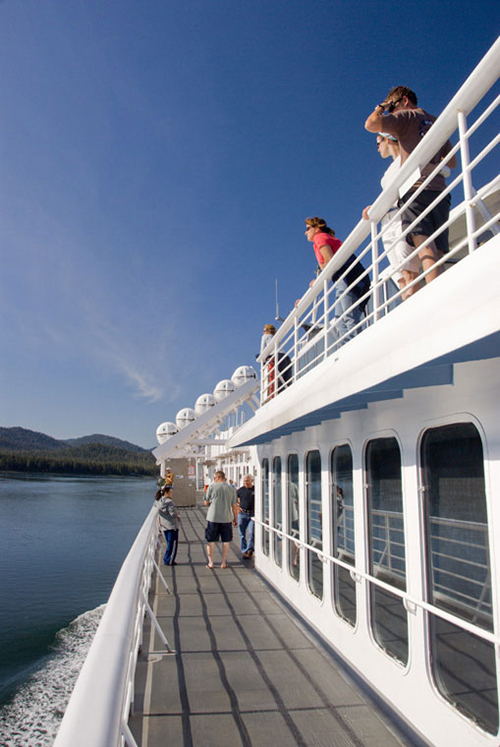
Take a stroll on the outside walk-around deck
The M/V TUSTUMENA, was built at Sturgeon Bay, Wisconsin in 1964, sailed Alaskan waters for five years, then was renovated in San Francisco in the winter of 1969. The vessel is 296 feet long, with capacity for 36 vehicles and operates at a service speed of 13.5 knots. It can carry 174 passengers, and has 8 four-berth, and 18 two-berth cabins. Passenger services include a cafeteria, cocktail lounge, solarium, and forward observation lounge. An ocean-going vessel, the M/V Tustumena usually operates from Homer and Kodiak and goes all the way out the Aleutian Chain to Unalaska/Dutch Harbor.
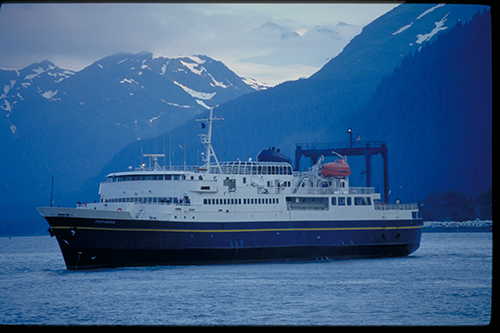
The M/V LITUYA serving the Inside Passage route between Ketchikan and Metlakatla, went into service in 2004. At 181 feet overall, she can carry 18 vehicles and 149 passengers. Service speed is 12 knots.
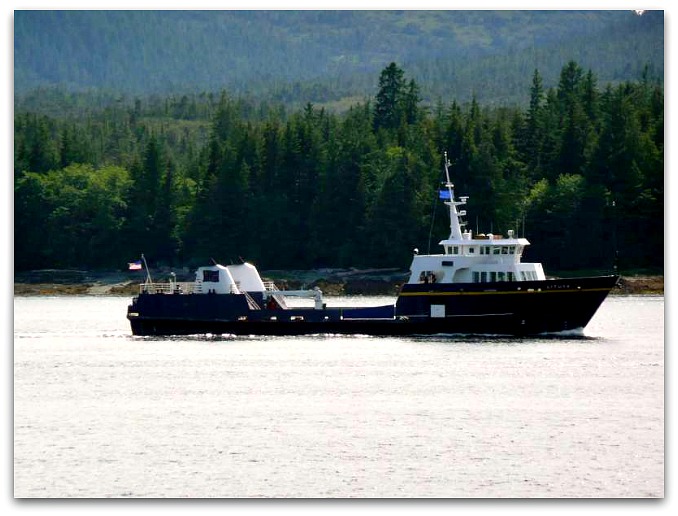
The MV Tazlina and MV Hubbard are both named after Alaska Glaciers, like all of the Alaska Marine Highway ships. The vessels were designed by Elliott Bay Design Group of Seattle, Washington and constructed at Vigor Shipyard in Ketchikan, Alaska.
The MV Tazlina is the first Alaska Marine Highway ferry built in Alaska, along with its sister ship the MV Hubbard. The MV Tazlina was christened in Ketchikan on August 11, 2018 by former First Lady, Donna Walker and began service in May, 2019. The Tazlina operates as a day boat in North Lynn Canal between the communities of Juneau, Haines and Skagway. The MV Hubbard was completed about a year later.
The ships are 280 feet long, seat up to 300 passengers each and carry 53 standard vehicles. Onboard amenities include observation lounges with comfortable chairs, a covered heated solarium, a cafeteria-style restaurant, a children's play area and a quiet room.
